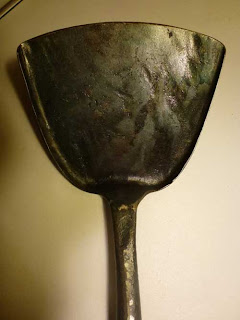I love a good laksa soup. Usually I'd go for a mild green laksa like the chicken and prawn laksa soup served by The Banana Tree Café where the delicate flavours of coconut, sesame oil, lime and coriander top notes meld sensitively into a warm, comforting hug on the tongue, backed up by umami from fish sauce and garlic.
However, sometimes you just want a flavour bomb that detonates all over your taste buds. After a long search through the various laksa pastes available I have found the perfect one that does the job.
The star of the pastes for me is the Tumisan Kari Laksa paste by Teans Gourmet that comes in 125g and 200g foil pouches.
The pastes I've been trying tend to use too much vinegar or acetic acid as a preservative which is the wrong sort of sour and can overpower the other flavours. I used Yeo's jars of laksa paste for a while but the latest batch is all coconut and not much flavour. The Tumisan is the way I like my men: thick, rich and hot with a lot of depth. Although this is strong, its heat leaves a pleasant tingle that lingers. If you really want knock-your-socks-off-hot, just add more chillis.
One day I will attempt to make my own from the long list of ingredients, leaving out the E621 monosodium glutamate and other E numbers. But for a fast ready-made, this is perfect.
INSTRUCTIONS:
The instructions say to dissolve one 200g packet in 1,600 simmering water for 8-10 minutes, then add 150ml coconut milk and fried bean curds. Bring to boil and add already cooked noodles, slices of cooked meat, fish cakes, hard boiled egg and mint leaves. Et voila. That's how fast this is.
I did it my own way, however, frying half the paste plus the sliced white ends of spring onions in a tablespoon of oil. Then adding raw chicken slices (thick cut), two bashed sticks of lemon grass, 6-10 lime leaves, 4-6 crushed garlic cloves, two small sliced fresh chillies (or crushed chilli seeds) and continue to fry.
After a few minutes, add a tin of coconut milk, half a cup of fish sauce, the remaining curry paste, the juice of four limes, and a litre of stock made from four Kallo chicken cubes, and simmer for ten minutes. The chicken should be delicately soft and not rock hard from over-cooking. You can add coriander stalks. Garnish with coriander leaves and sliced green spring onions. If adding these extra spices and aromats, you can get away with the 125g size.
Near the end you can add a block or three of egg noodles and simmer for 4 minutes. Or serve up a thicker version (less stock) on rice.
I'm still trying to perfect a boiled egg on top that is thoroughly cooked but where the yolk runs yummily when cut.
I'll post a pic next time around.
Price locally around £2, double on Amazon.
Available from Starry Mart, Oriental Mart and Amazon.








